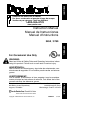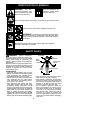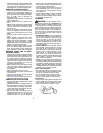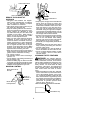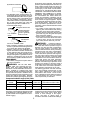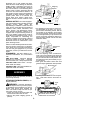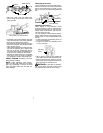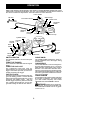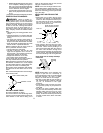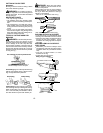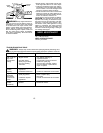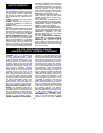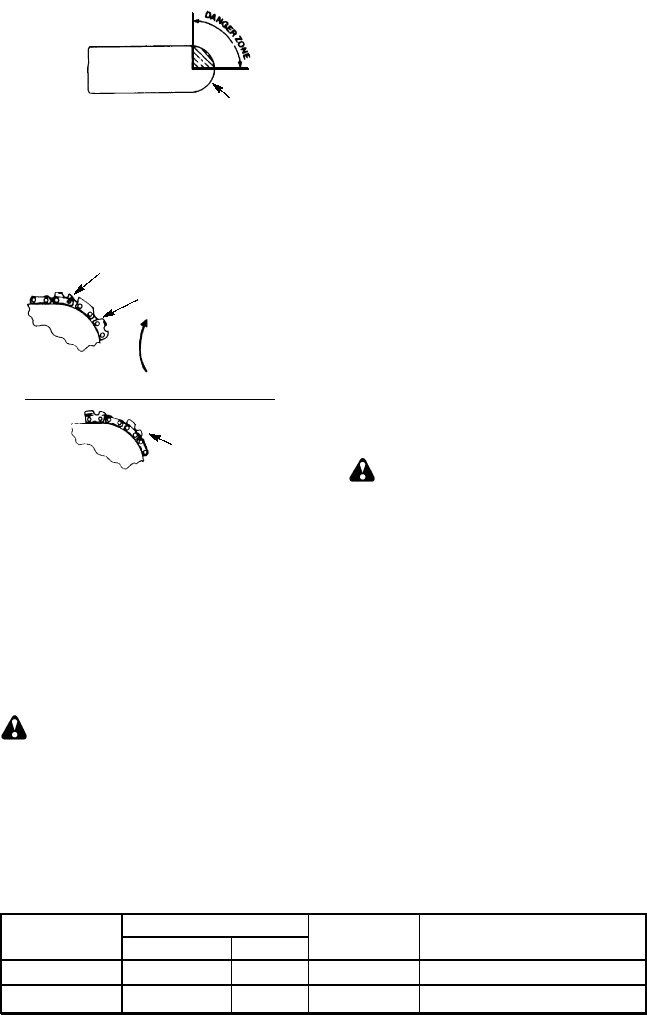
5
Symmetrical Guide Bar
Large Radius Tip
S
Low- Kickback Chain, designed w ith a con-
toureddepthgauge and guar dlink whichde-
flectkickbackforceandallowwood togradu-
ally ride into the cutter . Low-Kickback Chain
has m et kickback performance r equire-
ments w hentested ona r epr esentativesam-
ple of chain saws below 3.8 cubic inch
displacement specified in ANSI B175.1.
Low--Kickback
Chain
Not a Low--Kickback Chain
Can Obstruct
Material
Contoured Depth Gauge
Elongated Guard Link
Deflects kickback
force and allows
wood to gradually
ride into cutter
S
Front Handguar d, designed to r educe the
chance ofyourleft handcontacting thechain
if your hand slips off the front handlebar.
S
Position of front and rear handlebars, de-
signed with distance between handles and
“in-line” w ith each other. The spread and “in-
line” position of the hands provided by this
design w or ktogetherto give balance andre-
sistanc e in contr o lling the pivot of t he saw
back toward the operator if kickback occur s.
CHAIN BRAKE
S
Chain Brake, designed to stop the chain in
the event of kickback.
WARNING:
WE DO NOT REP-
RESENT AN D YOU SH OUL D NOT AS -
SUM E THAT THE CHAIN BR AKE W ILL
PROTECT YOU INTHE EVEN TOF A KICK-
BACK. Kickback is a lightning fast action
which throw s the bar and rotating chain back
and up towar d the operator. Kickback can be
caused by allowing contact of the bar tip in the
danger zone with any hard object. Kickback
can also be caused by pinching the saw chain
along the top of the guide bar. This action m ay
push the guide bar rapidly back toward theop-
erator. Either of these events may cause you
to lose control of the saw which could result in
serious injury or even death. DO NO T RELY
UPON ANY OF THE DEVICES BUILT INTO
YOUR SAW. YOU SHOULDUSE THE SAW
PROPERLY AND CAREFULLY T O A VOID
KICKBAC K. Reduced--kickback guide bars
and low--kickback saw chains r educe the
chance and magnitude of kickback and are
recommended. Your saw has a low kickback
chain and bar as original equipment. Repairs
on a chain br ake shouldbe made by anautho-
rized servicing dealer. Take your unit to the
place of purchase if purchased from a servic-
ing dealer, or to the nearest authorized master
service dealer.
S
Tip contact in some cases may cause a
lightning fast reverse REACTION, kicking
guide bar up and back toward operator.
S
Pinching the sawchain along the top ofthe
guide bar may push the guide bar rapidly
back toward the operator.
S
Either of these reactions maycause youto
lose control of the saw which could result
in serious injury. Do not rely exclusively
upon safety devices built into your saw.
WARNING:
Computed kickback
angle (CKA) listed on your saw and listed in
the CKA table below represents angle of
kickback your bar and chain combinations
will have when tested in accordance with
CSA and ANSIstandards. Whenpurchasing
replacement bar and chain, considerations
should be given to the lower CKA values.
Lower CKA values represent safer angles to
the user, higher values indicate more angle
and higher kick energies. Computed angles
represented in the non-activated column in-
dicate total energy and angle associated
without activation of the chain brake during
kickback. Activated angle represents chain
stopping time relative to activation angle of
chain brake and resulting kick angle of saw .
In all cases lower CKA values represent a
safer operating environment for the user .
The following guide bar and chain combina-
tions meet kickback requirements of CSA
Z62.1, Z62.3, & ANSI B175.1 when used on
saws listed in this manual. Use of bar and
chain combinations other than those listed is
not recommended and may not meet the
CKA requirements per standard.
Computed kickback angle (CKA) Table
BAR
P/N
Length
CHAIN P/N
20!
MODEL
530044723 952051459
23
_
CKA without chain brake
3450
3750
22!
530044544 952051266
21
_
NOTE
: If this saw is to be used for commer-
cial logging, a chain br ake isrequired and shall
not be removed or otherwise disabled to com-
ply with Federal O SH A R egulations for Com-
mercial Logging.
SAFETY NOTICE:
Exposure to
vibrations through prolonged useof gasoline
powered hand tools could cause blood
vessel or nerve damage in the fingers,
hands, and joints of people prone to
circulation disorders or abnormal swellings.



